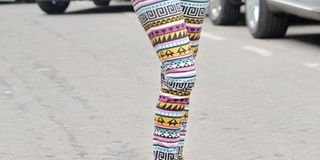Should we be nurturing the gains of liberation or turning back the clock?

A model in printed pants. We need to consider more seriously the mechanics of culture and the difficulties of prescribing it from above. PHOTO: EMMA NZIOKA/NATION
What you need to know:
- When did a woman’s bare thighs become an unbridled licence to male lust? When did women’s breasts stop being mammary glands and become sexual organs?
- Mary Ondieki aka Orie Rogo Manduli and Mrs Sylvia Omino launched their debut entry into the East African Safari Rally in 1974 clad in arresting “hot pants”.
One of the most illustrative Kenyan photographs of the 1960s shows an unnamed woman weeping over an open casket containing the body of the slain Tom Mboya.
That photograph is an iconic representation of Africa’s era of “big man” politics that was partly sustained by assassinations such as Mboya’s.
Acres have been written about that dictatorship and about Mboya’s premature death. But what is seldom commented upon, publicly, is that unnamed woman’s fashion sense — a statement about changing times and African modernity.
Likewise, little has been written about the cultural meanings of the black mini-dress, nylon stockings and pointed stiletto shoes that Pamela Mboya wore when bewildered mourners escorted her to the City Mortuary on July 6, 1969.
The contrast between the women’s elaborate head-dresses rising upwards in yards of printed fabric and the raised hem-lines of their minis was a testament to the fluidity of African culture.
Our culture grabs and mixes styles and practices from everywhere. It is not a static shrine that binds its worshippers in uninterrupted rituals that have lost all potency.
In Coast, county debates propose the banning of miniskirts and other “indecent dress”, including men’s dreadlocks. They cite the need to preserve our traditions. They say our culture must be shielded from harmful external influences that disrespect them as “places that uphold culture and heritage”.
First, claims to what is African suggest a purity that does not exist. Our aggressively acquisitive culture is burdened by contradictions.
BARE-BREASTED
Was the hijab native dress amongst the populations in Coast? Is it held in place by county laws or by inherited belief systems? Were women part of the leadership in ancient Lamu?
Many things that we call local were borrowed from some influence that hit our shores at some point. Chapati and pilau, today’s standard fare at our feasts, were not the culinary genius of our great grandmothers.
Secondly, every place has a heritage — slums, urban jungles like Majengo, city council estates, even the privileged suburbs.
One has only to do a little memory work to unearth that heritage and quit the snotty attitude that one’s claims to ancient Africa are more legitimately local than the games of kati, mjusi kafiri and songs of “wamama wawili” and ‘Ba ba Black sheep” that urban children were reared on.
When we complain about rising hemlines, we forget that modesty is a mutable social construct. Not too long ago, our women walked bare-breasted (they still do in parts of Kilifi, Pokot and Turkana) and our men’s buttocks remained exposed behind skimpy loin-cloths.
When did a woman’s bare thighs become an unbridled licence to male lust? When did women’s breasts stop being mammary glands and become sexual organs?
Our religious encounter with the Arabian Peninsula and our meeting with the puritan mannerisms of Victorian England, which accompanied the Bible on its journey to our shores are the more plausible explanations for how a people who walked half-naked just recently suddenly became averse to the public sight of women’s breasts and thighs.
BOLD AND SYMBOLIC
But aside from these lessons in cultural histories, we need to consider more seriously the mechanics of culture and the difficulties of prescribing it from above. That is why a 2003 committee to design a national dress completed its task with a flourish, but its designs failed to take root, never mind their frequent display by Mr Moody Awori and Mr Najib Balala.
Mary Ondieki aka Orie Rogo Manduli and Mrs Sylvia Omino launched their debut entry into the East African Safari Rally in 1974 clad in arresting “hot pants”. It was a bold and symbolic act. It invited the generations of their daughters to break the glass ceiling in every male-dominated field.
Next month, “Our mothers in miniskirts”, a photo exhibition that is the brainchild of poet Sitawa Namwalie will open at a virtual space near you.
Meanwhile, visit any home that boasts those old black and white stills from Nimmi Photographers and Studio One to see the glamour of our yesteryears — raised hemlines, crimplene pants, hot-combed locks, raffia braids and stiletto shoes.
Dr Nyairo is a cultural analyst. ([email protected] Twitter: @santurimedia





